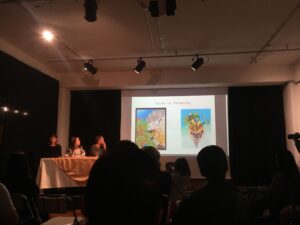Engaged Anthropology Grant: Amelia Fiske

In 2012 Dr. Amelia Fiske received a Dissertation Fieldwork Grant to aid research on “The Making of Harm in the Ecuadorian Amazon,” supervised by Dr. Margaret J. Wiener. When Dr. Fiske was awarded an Engaged Anthropology Grant in 2019 she was able to return to Ecuador to aid engaged activities on, “Toxic Inheritance: Our Common Chemical Constitutions and dependencies”.
We are living in the “age of toxicity” (Walker 2011, ix). Oil and its derivatives surround us. As one of the principal drivers of anthropogenic change today, oil production has rapidly transformed how life is lived around the globe. Lago Agrio and the surrounding oil producing areas of the Ecuadorian Amazon are a prime example of a pressing predicament of the present: the very petrochemical compounds that sustain our lives today also produce tremendous harm.

Throughout ethnographic fieldwork in the region that grew up around the first wells drilled by the Texaco Company in the 1960s, I observed how the toxicants used and produced in oil production cross boundaries. Toxicants routinely breached the industrial membranes built to retain the contents of wastepits, spills, and the effects of industry more broadly. While official accounts insist that harm from oil is controlled with advanced technology, everyday life in the region contests this.
While writing up my PhD research, I wanted to find a way to capture the experiences of toxicity described to me by residents of the region. Some spoke of “swimming in oil” while washing clothes in the river, or seeing “smoke thick like marmalade” that plumed from the gas flares. As one man noted, they were “naked in the face of contamination.” In search of a creative format to express these experiences, I began to explore graphic storytelling of ethnographic research.

In 2018, while living in Germany, my path crossed with Jonas Fischer. A graphic arts and design student, Jonas had already published a graphic book with archaeologists, and had experience working with scientific information in a visual format. We began to work together to create a graphic article, Herencia Tóxica (Toxic Inheritance), to delve into questions of toxicity and contamination in the Ecuadorian Amazon. Based on my ethnographic findings, the graphic article is intended to be an open, accessible invitation to contemplate the ways that all of our lives have been profoundly transformed by the toxins we live with and rely upon.

With support from the Wenner Gren Engaged Anthropology grant, in February 2020 Jonas and I travelled together to Ecuador to share Herencia Tóxica with the interlocutors I worked with while in the field and with the Ecuadorian public. In Quito, we exhibited the graphic article for a month at the Humboldt Association (see press coverage here). On the inaugural night of the exhibition, we hosted a public conversation on toxicity, with three invited speakers who have extensive experience working and living in the Amazon: Kati Alvarez, Santiago del Hierro, and Vanessita Roa. Speaking from their experiences as a sociologist, architect, and artist, they covered topics such as how graphic arts can be a tool for engaging in difficult questions surrounding our consumption of fossil fuels, or how to best represent the crisis of toxicity amidst a deluge of visual media. With more than 40 people present, members of the audience joined the conversation with questions and comments.
Poignant comparisons were drawn between how toxicity is experienced in oil producing areas of the Amazon and how it is experienced in urban spaces like Quito, and the legacies of US- based companies in Latin America.

Following the exhibition, Jonas and I traveled to the Lago Agrio. We spent a day at Amisacho, an environmental education and reforestation center, where we exhibited the graphic article. Interlocutors that I had spent time with during my fieldwork offered their reflections on how the graphic article related to their own experience, such as arriving in the 1970s to claim land during Agrarian Reform, or walking along oil pipelines on the way to school. With invited community groups, activists, and youth, we held a workshop on the use of comics in activism and education. For the culmination of the event, each participant worked on completing a short graphic “zine” on a topic of their choosing. Jonas and I led the group in making an 8-page zine from a single piece of folded paper, a grassroots technique that allows comics be easily scanned and reprinted for sharing with family members, neighbors, or for community organizing events. All materials, including printed copies of the article in poster and book format, as well as didactic tools from the presentation, were given to the Amisacho organizers as a “workshop packet” in order that facilitators can lead similar workshops in future. In the following days, we spent time with former interlocutors and distributed printed copies of Herencia Tóxica while visiting communities living adjacent to the oil camps of Sucumbíos and Orellana.

After decades of oil production in the Amazon, it is difficult to distinguish singular moments of hazard. Inviting the public to contemplate the ways that all of our lives have been profoundly transformed by the toxicants we live with and rely upon, Herencia Tóxica proposes that the chemically saturated present demands a reconfiguration of toxicity. Building from the feedback we received in Ecuador, we are now working on a full-length graphic novel on toxic tours in the Amazon which will be published in the ethnoGRAPHIC series of the University of Toronto Press. Our hope is that the graphic format will allow us to explore serious matters with creativity, and thus to engage more people in conversations about the toxic legacies of contamination.